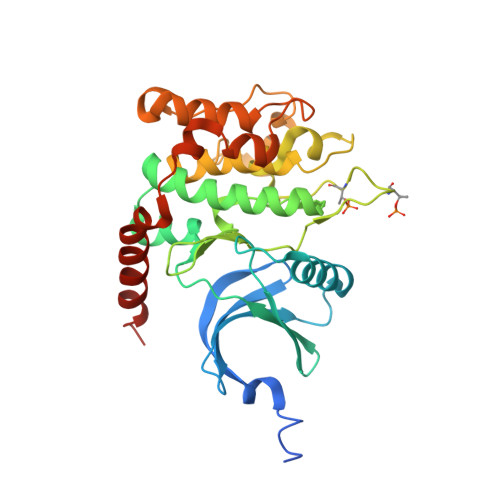Inhibitors of the Hippo Pathway Kinases STK3/MST2 and STK4/MST1 Have Utility for the Treatment of Acute Myeloid Leukemia.
Bata, N., Chaikuad, A., Bakas, N.A., Limpert, A.S., Lambert, L.J., Sheffler, D.J., Berger, L.M., Liu, G., Yuan, C., Wang, L., Peng, Y., Dong, J., Celeridad, M., Layng, F., Knapp, S., Cosford, N.D.P.(2022) J Med Chem 65: 1352-1369
- PubMed: 34807584
- DOI: https://doi.org/10.1021/acs.jmedchem.1c00804
- Primary Citation of Related Structures:
6YAT - PubMed Abstract:
Serine/threonine-protein kinases 3 and 4 (STK3 and STK4, respectively) are key components of the Hippo signaling pathway, which regulates cell proliferation and death and provides a potential therapeutic target for acute myeloid leukemia (AML). Herein, we report the structure-based design of a series of pyrrolopyrimidine derivatives as STK3 and STK4 inhibitors. In an initial screen, the compounds exhibited low nanomolar potency against both STK3 and STK4. Crystallization of compound 6 with STK4 revealed two-point hinge binding in the ATP-binding pocket. Further characterization and analysis demonstrated that compound 20 (SBP-3264) specifically inhibited the Hippo signaling pathway in cultured mammalian cells and possessed favorable pharmacokinetic and pharmacodynamic properties in mice. We show that genetic knockdown and pharmacological inhibition of STK3 and STK4 suppress the proliferation of AML cells in vitro. Thus, SBP-3264 is a valuable chemical probe for understanding the roles of STK3 and STK4 in AML and is a promising candidate for further advancement as a potential therapy.
Organizational Affiliation:
Cell and Molecular Biology of Cancer Program, NCI-Designated Cancer Center, Sanford Burnham Prebys Medical Discovery Institute, 10901 North Torrey Pines Road, La Jolla, California 92037, United States.


















